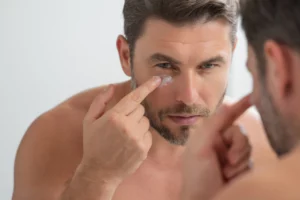A peel for Black and mixed-race skin is an aesthetic treatment designed to improve skin texture and appearance by exfoliating the superficial layers of the epidermis. Specifically formulated to meet the unique needs of darker skin tones, this peel uses gentle acids to avoid hyperpigmentation while stimulating cell renewal without irritating the skin. It helps address concerns such as dark spots, uneven skin tone, acne, and scarring. When performed by an experienced doctor, the peel restores a radiant, even, and brighter complexion, while preserving the delicacy of this skin type.
Chemical peeling is a widely used aesthetic medicine technique to improve the texture and radiance of the skin. However, when it comes to Black and darker skin tones, special care is required to avoid certain risks, particularly hyperpigmentation or scarring. Black skin has unique characteristics that make it more reactive to aggressive treatments — but this does not mean
that peels are unsuitable for this skin type. With the right protocols and personalized care, a peel for Black skin can deliver visible results : improvement of skin tone, reduction of pigmentation spots, and a decrease in imperfections.

• A peel on black skin requires special care due to several factors related to its unique characteristics.
Black skin contains a higher concentration of melanin in the epidermis. Melanin, which is responsible for pigmentation, provides natural protection against UV rays but also makes the skin more prone to irritation and skin trauma, which can lead to post-inflammatory hyperpigmentation. This means that an unsuitable or overly aggressive peel can cause dark spots or unwanted scarring.
• The dermis of black skin is generally thicker, which makes it more resistant to signs of aging — but also means that peels need to penetrate effectively without irritating the skin.
• Black skin often has a delicate balance between oily and dry areas, with oiliness commonly seen in the T-zone and dryness in other parts. Although there is an excess of sebum on the surface, the dermis itself is poorly hydrated. Choosing the right type of peel is therefore complex and requires precision.
• Skin reactivity is often more pronounced, making the skin more prone to inflammation. That’s why a peel for Black skin must be carefully customized to avoid side effects such as redness or irritation.

Le peeling présente de nombreux avantages pour les personnes à la peau noire, à condition qu’il soit effectué avec les bons produits et sous la supervision d’un médecin expérimenté.
Pigmentation spots and hyperpigmentation are common concerns for people with black skin. Whether due to acne scars, sun damage, or irritation, excess melanin can leave visible marks. A gentle chemical peel helps exfoliate the superficial layers of the skin and gradually fade these pigmentations, leading to a more even tone.
Black skin may sometimes appear uneven in texture, giving a dull or rough appearance. A well-chosen peel removes dead skin cells, smooths the skin’s texture, and restores a softer, more radiant look.
Peels help unclog pores and eliminate blackheads and other impurities. By exfoliating the skin, they also help prevent future breakouts and maintain a clearer complexion over time.
Unfortunately, acne scars cannot be treated with peels in darker skin tones, as the types of peels required (medium or deep peels) are contraindicated for pigmented skin due to the high risk of post-inflammatory hyperpigmentation.
For Black skin, it's essential to select peels that respect its sensitivity while minimizing the risk of post-inflammatory hyperpigmentation. The most commonly used peels for darker skin tones are :
Salicylic acid dissolves excess sebum, thereby reducing blackheads, enlarged pores, and breakouts.
Benefits : this peel treats acne, helps prevent future breakouts, and regulates sebum production.
Indications : acne, excess sebum, blackheads, enlarged pores, hyperpigmentation.
Glycolic acid, an AHA derived from sugarcane, is commonly used in superficial peels. While it can be used on Black skin, it must be handled with care to avoid irritation — hence the importance of consulting an experienced doctor. In low concentrations, it gently exfoliates the upper layers of the skin while stimulating cell renewal.
Benefits : smooths the skin, evens out skin tone, and enhances skin radiance.
Indications : mild hyperpigmentation, dull complexion, superficial wrinkles.
Mandelic acid peels are especially suited to Black skin because they penetrate slowly, minimizing the risk of irritation or hyperpigmentation. Mandelic acid is excellent for treating hyperpigmentation, dark spots, and mild acne, offering a gentle exfoliating action.
Benefits : this peel works gently to even out skin tone and smooth texture.
Indications : oily skin, mild acne, hyperpigmentation, uneven tone.
The Jessner peel is a blend of several exfoliating agents (salicylic acid, lactic acid, and resorcinol). It is recommended for treating hyperpigmentation and dark spots on darker skin tones. However, this peel must be used carefully by an experienced doctor to avoid irritation.
Benefits : deeply exfoliates the skin, improves texture and tone, and helps reduce imperfections.
Indications : acne-prone skin and pigmentation spots.
The number of sessions depends on the issue being treated. In general, for darker skin types, 4 to 6 peel sessions spaced 2 to 4 weeks apart are recommended to achieve visible and lasting results. Doctor Romano will offer you a personalized treatment plan based on your specific needs.
Darker skin is more prone to post-inflammatory hyperpigmentation after aggressive treatments. It is therefore crucial to take certain precautions before undergoing a peel.
• Consult an experienced doctor : it is essential that the peel be performed by a qualified doctor experienced in treating darker skin tones. The type of peel, acid concentration, and session frequency must be tailored to each patient.
• Do a patch test first : before any treatment, a test on a small area of the skin is recommended to check for tolerance and avoid any risk of reaction or hyperpigmentation.
• Avoid aggressive peels : medium peels and deep peels are contraindicated for darker skin tones, as they can lead to scarring or hyperpigmentation.
• Prepare your skin : before a peel, it is advisable to use products containing azelaic acid or vitamin C to help even out skin tone and reduce the risk of pigmentation after treatment.
• Sun protection : sun protection is crucial both before and after a peel, especially for darker skin tones. Use a broad-spectrum SPF 50 sunscreen to protect the skin from UV rays at least one month prior to the peel, in order to prevent the appearance of dark spots.

After a peel, the skin may become more sensitive, red, or slightly flaky for a few days. These side effects are normal and usually resolve quickly. To maximize results and avoid complications, it is important to follow post-peel care instructions carefully.
• Hydration : use a gentle, non-comedogenic moisturizer to support healing and prevent dryness.
• Sun protection : apply sunscreen daily, even if you're not directly exposed to sunlight. This helps protect the skin and prevent pigmentation spots.
• Avoid harsh products : after a peel, do not use retinoids or other irritating products for at least one month, to avoid further irritation.
The price of a peeling session for dark and mixed skin is 200 CHF. This amount remains the same regardless of skin type or the intended goal. The frequency of sessions can be adjusted based on needs and skin evolution, following a personalized evaluation. The stated price applies to each session performed at Dr. Romano’s clinic in Geneva.
Pour la peau noire, les peelings doux et progressifs sont recommandés afin d’éviter le risque d’hyperpigmentation. Le peeling à l’acide mandélique est idéal pour les peaux sensibles et foncées, car il agit en douceur. L’acide lactique est également efficace pour hydrater et unifier le teint. Pour les taches pigmentaires, le peeling à l’acide glycolique ou kojique peut être envisagé, mais avec précaution.
Exfoliate dark skin with gentle products, such as enzymatic exfoliants or light acids (mandelic or lactic). Avoid harsh mechanical scrubs, which can cause micro-irritation and lead to hyperpigmentation. Once-a-week exfoliation is enough to maintain skin radiance without causing damage.
Yes, chemical peels are suitable for dark skin, but they must be carefully selected. Mild acids are preferred to minimize pigment-related side effects. It is essential to consult a physician experienced in treating darker skin tones to ensure safe and effective results.
Théoriquement, les peelings peuvent atténuer les taches pigmentaires sur les peaux noires. Les peelings à l’acide glycolique, kojique ou mandélique sont efficaces pour unifier le teint. Le traitement doit être associé à une protection solaire stricte pour éviter le risque d’hyperpigmentation post-inflammatoire. Toutefois, les résultats sont variables et souvent très légers.
Oui, le peeling chimique est efficace contre l’acné sur les peaux foncées. Les peelings à l’acide salicylique ou mandélique sont particulièrement recommandés, car ils régulent le sébum, désobstruent les pores et réduisent les imperfections tout en minimisant le risque de taches pigmentaires.